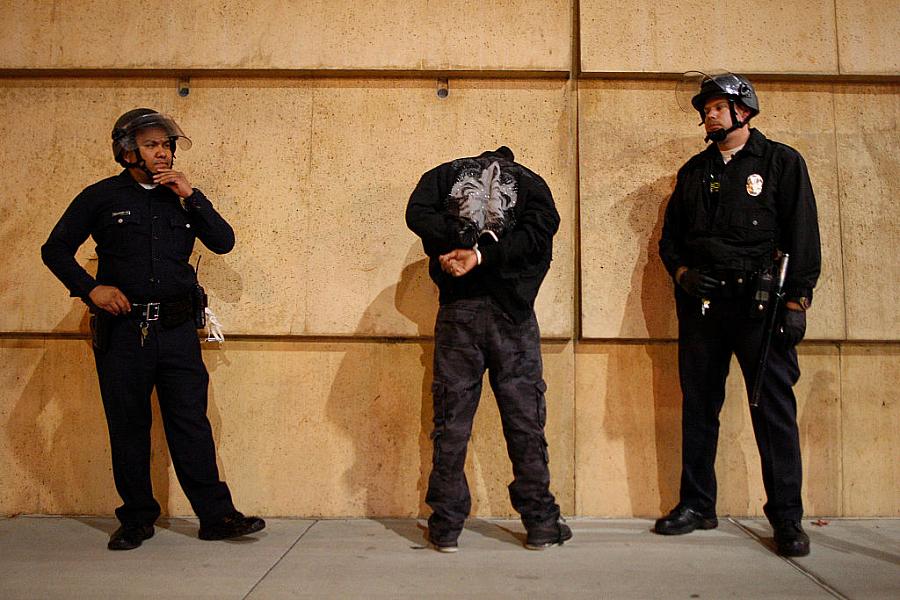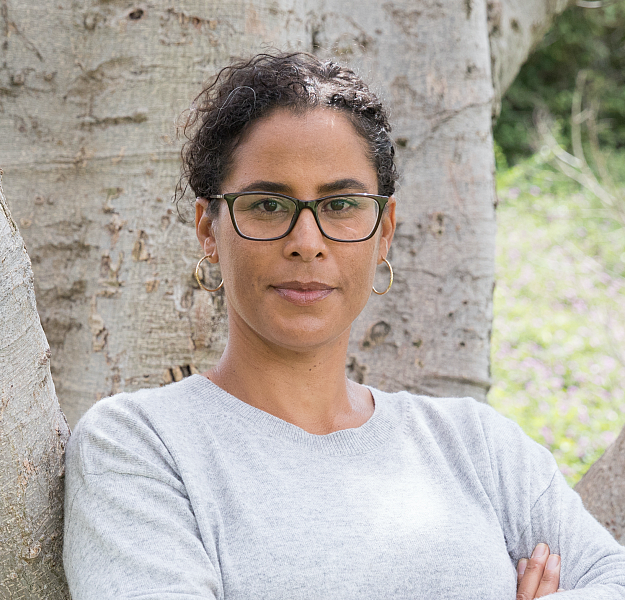An innovative data storytelling project reveals the dirty secrets of LA policing

(Photo by David McNew/Getty Images)
Kelly Lytle Hernandez is a UCLA scholar-activist with the instincts of a journalist. Her work sheds new light on this moment in which the nation is confronting racism embedded in policing, mass incarceration, health and other systems. Through Million Dollar Hoods, an innovative data and storytelling project based on police booking reports, Hernandez and her team revealed that Los Angeles residents were most often arrested for health conditions related to poverty, addiction, and mental illness, not for violent activity. The problems that get people locked up must be addressed, she says, but not by policing.
Million Dollar Hoods draws its name from the fact that more than $1 million a year is spent to incarcerate residents of particular neighborhoods in LA — places where low-income people of color live. Through developing data strategies in partnership with residents and advocates, the organization has helped win policy changes and improve law enforcement transparency across California. Hernandez is a professor of history, African American studies and urban planning at UCLA, where she also directs the Ralph J. Bunche Center for African American Studies. In 2019, she was honored with the prestigious MacArthur Foundation “genius grant” fellowship.
Q. What did you learn by hearing from community members most impacted by policing and incarceration?
A. When I was on a sabbatical, I spent a lot of time listening to organizers, going to meetings and getting to know folks who were on the front lines of social justice movements. At one of those meetings, people were talking quite a bit about data. They said, “We know who is being arrested and incarcerated. It’s us, it’s our neighbors and our loved ones. But whenever we ask the police for the data, they won’t give it to us.” As a scholar, that caught my attention because a lot of what we do at the university is to get access to evidence and analyze it. I thought we could use the power of our institution to open up some doors.
Q. You didn’t have any prior experience in requesting or analyzing police records. How did you go about getting the data?
A. I started by asking for data randomly, and someone in the sheriff’s department told me I needed to make a California Public Records Act request. Over time, I’ve become a bit of an expert on the sections of the law that have to do with police records. I also received support from the ACLU of Southern California to help frame my requests so that they would be successful.
The first obstacle we encountered was the law enforcement “culture of no” when it comes to public requests for data. If frontline workers had any discretion to refuse requests, they did. The second obstacle had to do with funding. If you don’t want to provide data, one way of blocking that access is to underfund the department that is supposed to do that work. At one point, a Los Angeles Police Department staffer who was responding to my request emailed me to say, “I can’t answer this right now. You need to be patient because I’m the only person working in this office.” That’s absolutely ridiculous for the LAPD, given the number of public record requests that they receive.
I and others faced so many roadblocks that a lawsuit seeking new procedures and openness was filed on our behalf by the ACLU. Among other things, the lawsuit settlement required the LAPD to create a new web site where you can see all the public record act requests that have been submitted and the data that was provided. That’s been a part of our process, making sure that law enforcement data becomes more accessible and therefore law enforcement becomes more accountable.
Q. How did you go about organizing and cleaning the data?
A. The data arrived in such terrible condition that we had to put together a team at UCLA to be able to extract the information, clean it up and make it usable. Many law enforcement agencies have told us they know they are required to collect certain data that we request, but they don’t have it. They don’t keep the data, or don’t have a way to access it. Or it will be in four different databases, and they give us four different data sets that don’t have a through-line to pull it all together, like a single identifier. It’s taken an extraordinary amount of work to build the team and the internal capacity to be able to work with these records.
Q. What was most surprising to you about the data?
A. I was surprised by how dirty the data was. If the data is that dirty, how is law enforcement even running their own reports? Either they are cleaning the data to run their own reports and giving us the dirty stuff, which is wrong. Or they’re running reports from dirty data. It’s a problem either way.
The other thing that struck me was the difference between how the police tell their story and what we were seeing on the ground. The narrative they have about policing is that it keeps us safe from what people think of as violent crime. But the arrest data shows that police officers don’t spend the majority of their time confronting people engaged in violent activity. We found a large number of arrests for health-related charges, namely DUIs and drug possession.
When you really look at the list of arrest charges, you see that policing is largely dedicated to locking up folks who have health- and poverty-related crises in their lives. Their job is about managing the unemployed, managing the houseless, managing neighbor disputes, managing mental health crises, substance abuse and domestic crises. All of these need to be addressed, but policing can’t solve these problems.
Q. Why do you prioritize working with residents and organizers as you develop your data strategies?
A. This is a project that began in community and has always been directed by people most impacted by mass incarceration and policing. Together we talked about how we wanted to analyze the data, what questions we want to ask of it and how we want to visualize it. In Los Angeles, we spent quite a bit of time talking through the neighborhood names and boundaries that got us closest to everyday meaning. We also used ZIP codes because they are familiar to folks and ran our mapping through census blocks. We wanted to reflect the true arrest clusters happening on the ground, and tell an accurate story.
Kelly Lytle Hernandez
That kind of work happens in dialogue between those of us who can acquire the data, those of us who have been doing this for 20 years and know about the codes, community members coming together and saying how they have been impacted by policing, and with a variety of advocates on the ground.
Q. What’s next for Million Dollar Hoods?
A. We’re going to begin a large archival project to collect the oral histories of people most impacted by policing and mass incarceration, and the organizers who have helped get us to this moment of decarceration. We’re also collecting the ephemera of the age of mass incarceration — the bail bond receipts, the mixtapes and other personal records. And we will continue to offer data training so that people in the most impacted communities can do more of this work themselves.
Q. Are you hopeful about justice reform and ending mass incarceration?
A. We’re very much at a new juncture. In the COVID era in Los Angeles, the county jail population has been reduced by about a third and there’s a commitment to drive that number even lower. The Los Angeles County Board of Supervisors has unanimously agreed to a comprehensive Alternatives to Incarceration plan that will stop policing and punishment from being used as the first-line response to social crises. All of that is happening and it’s very good.
And yet I also have considerable concern about where we go from here. I’ve heard law enforcement express support for reducing the number of people locked up in county jail, but only if there are “locked beds” in the community, which sounds like dispersing the jail population rather than reducing it. I hear support for investing in community-based services as alternatives to incarceration, but I don’t see a shared commitment to having the most impacted community members and families directing these programs. I’m concerned that we’re going to be using technology, housing vouchers and more to monitor and control people. I’m not sure we’re really heading in the direction of something that is truly transformative in terms of racial justice. As Michelle Alexander has pointed out to us, we may just be reconstituting Jim Crow laws in a new form.
**

